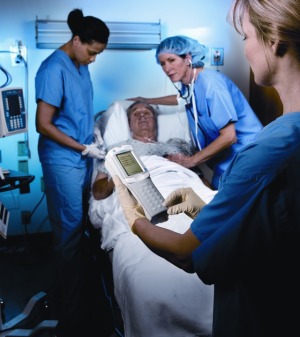Hospital point-of-care testing advances, spreads
by
Loren Bonner, DOTmed News Online Editor | April 15, 2013

Courtesy of Abbott Point of Care
Loyola University Medical Center in Chicago began using point-of-care testing more than a decade ago as a way to simplify and speed up patient decision-making when hospital beds and resources were scarce.
In a place like the emergency room that sees an increasing volume of patients, the technology made a lot of sense.
"This large influx of patients sets up a scenario where it's imperative that we are able to do more rapid assessments of patients so as to determine who has a time-critical emergency versus those who have something less than time-critical," Mark Cichon, medical director of emergency medical services at Loyola, told DOTmed News.
The devices that come under point-of-care testing are able to provide a greater depth of triage to determine which cases need to be treated immediately for life-threatening illnesses, according to Cichon. Some of these conditions include stroke, heart attack, sepsis and trauma. In addition, these types of cases will grow rapidly through the years as the population ages, Cichon said.
"These require much quicker evaluations to institute treatments more efficiently to be effective in their care," he said.
For example, when diagnosing heart attack patients, providers at Loyola Medical Center use a handheld point-of-care device with a special cartridge that can test for cardiac biomarkers from a blood sample.
Some of the newer devices that are used in point-of-care testing, which many hospitals like Loyola are switching over to, are able to transmit results wirelessly and in real time into the patient's electronic health record.
For example, Abbott Point of Care now sells a model of its handheld, diagnostic i-STAT system that is wireless so that physicians can review patients' test results immediately in an EHR — a key resource for treatment decisions in today's health care environment, according to a statement from the company.
Spreading across hospital departments
Although emergency departments require some of the most time sensitive information about patients, point-of-care testing is useful in other departments as well. In radiology, for example, Abbott said point of care tests can expedite and make creatinine tests more efficient. Creatinine tests are used when patients receive an imaging agent with a scan. Because those agents can cause certain problems for people with certain conditions, a creatinine test can help minimize the risks.
Although point-of-care devices like this come with a hefty price tag price, Cichon said the benefits and savings outweigh any cost, in addition to boosting patient satisfaction and staff morale.
"It might be 40,000 for a couple of devices but the savings are in the hundreds of thousands," said Cichon.
A device like the i-STAT is currently used in one out of every three U.S. hospitals and over 500 emergency departments across the country.
|
|
|
You Must Be Logged In To Post A Comment
|
